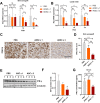Multiple Injections of Adipose-Derived Stem Cells Improve Graft Survival in Human-to-Rat Skin Xenotransplantation through Immune Modulation
- PMID: 37531072
- PMCID: PMC10519904
- DOI: 10.1007/s13770-023-00552-x
Multiple Injections of Adipose-Derived Stem Cells Improve Graft Survival in Human-to-Rat Skin Xenotransplantation through Immune Modulation
Abstract
Background: Adipose-derived stem cells (ADSCs) exert immunomodulatory effects in the treatment of transplant rejection. This study aimed to evaluate the effects of ADSCs on the skin graft survival in a human-to-rat xenograft transplantation model and to compare single and multiple injections of ADSCs.
Methods: Full-thickness human skin xenografts were transplanted into the backs of Sprague-Dawley rats. The rats were injected subcutaneously on postoperative days 0, 3, and 5. The injections were as follows: triple injections of phosphate-buffered saline (PBS group), a single injection of ADSCs and double injections of PBS (ADSC × 1 group), and triple injections of ADSCs (ADSC × 3 group). The immunomodulatory effects of ADSCs on human skin xenografts were assessed.
Results: Triple injections of ADSCs considerably delayed cell-mediated xenograft rejection compared with the PBS and ADSC × 1 groups. The vascularization and collagen type 1-3 ratios in the ADSC × 3 group were significantly higher than those in the other groups. In addition, intragraft infiltration of CD3-, CD4-, CD8-, and CD68-positive cells was reduced in the ADSC × 3 group. Furthermore, in the ADSC × 3 group, the expression levels of proinflammatory cytokine interferon-gamma (IFN-γ) were decreased and immunosuppressive prostaglandin E synthase (PGES) was increased in the xenograft and lymph node samples.
Conclusion: This study presented that triple injections of ADSCs appeared to be superior to a single injection in suppressing cell-mediated xenograft rejection. The immunomodulatory effects of ADSCs are associated with the downregulation of IFN-γ and upregulation of PGES in skin xenografts and lymph nodes.
Keywords: Adipose-derived stem cells; IFN-γ; PGES; Skin xenograft.
© 2023. Korean Tissue Engineering and Regenerative Medicine Society.
Conflict of interest statement
The authors declare that they have no conflicts of interest. None of the authors have a financial interest in any of the products, devices, or drugs mentioned in this manuscript.
Figures







Similar articles
-
Impact of Injection Frequency of Adipose-Derived Stem Cells on Allogeneic Skin Graft Survival Outcomes in Mice.Cell Transplant. 2021 Jan-Dec;30:9636897211041966. doi: 10.1177/09636897211041966. Cell Transplant. 2021. PMID: 34538121 Free PMC article.
-
Periurethral injection of autologous adipose-derived stem cells with controlled-release nerve growth factor for the treatment of stress urinary incontinence in a rat model.Eur Urol. 2011 Jan;59(1):155-63. doi: 10.1016/j.eururo.2010.10.038. Epub 2010 Oct 26. Eur Urol. 2011. PMID: 21050657
-
Intratunical Injection of Genetically Modified Adipose Tissue-Derived Stem Cells with Human Interferon α-2b for Treatment of Erectile Dysfunction in a Rat Model of Tunica Albugineal Fibrosis.J Sex Med. 2015 Jul;12(7):1533-44. doi: 10.1111/jsm.12916. Epub 2015 Jun 10. J Sex Med. 2015. PMID: 26062100 Free PMC article.
-
[Effect of adipose-derived stem cell derived exosomes on angiogenesis after skin flap transplantation in rats].Zhongguo Xiu Fu Chong Jian Wai Ke Za Zhi. 2019 Dec 15;33(12):1560-1565. doi: 10.7507/1002-1892.201904023. Zhongguo Xiu Fu Chong Jian Wai Ke Za Zhi. 2019. PMID: 31823559 Free PMC article. Chinese.
-
Allogeneic and xenogeneic transplantation of adipose-derived stem cells in immunocompetent recipients without immunosuppressants.Stem Cells Dev. 2012 Oct 10;21(15):2770-8. doi: 10.1089/scd.2012.0176. Epub 2012 Jul 3. Stem Cells Dev. 2012. PMID: 22621212 Free PMC article. Review.
Cited by
-
Role of Non-Coding RNAs in White and Brown Adipose Tissue Differentiation and Development.Noncoding RNA. 2025 Apr 29;11(3):30. doi: 10.3390/ncrna11030030. Noncoding RNA. 2025. PMID: 40407588 Free PMC article. Review.
References
-
- Simeonovic CJ, Townsend MJ, Karupiah G, Wilson JD, Zarb JC, Mann DA, et al. Analysis of the Th1/Th2 paradigm in transplantation: interferon-gamma deficiency converts Th1-type proislet allograft rejection to a Th2-type xenograft-like response. Cell Transplant. 1999;8(4):365–373. doi: 10.1177/096368979900800404. - DOI - PubMed
Publication types
MeSH terms
LinkOut - more resources
Full Text Sources
Research Materials
